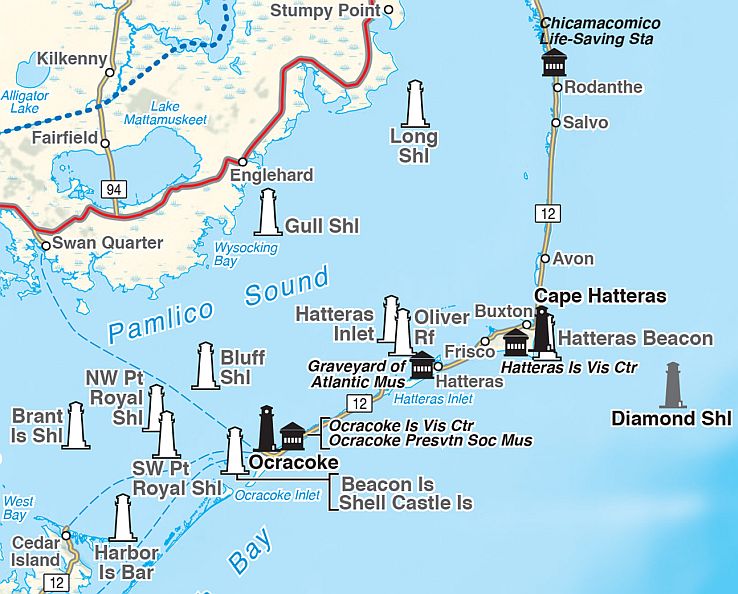Across the vast expanse of the United States, lighthouses rise majestically along our coastlines, standing as both sentinels and symbols of maritime heritage. With their striking silhouettes against endless skies and tumultuous seas, these architectural marvels capture the imaginations of travelers and history buffs alike. Venturing into the world of American lighthouses offers a captivating journey steeped in maritime history, stunning landscapes, and the promise of adventure.
Let’s embark on an enlightening exploration of these coastal beacons, uncovering their stories, significance, and how to map your voyage along the shoreline where they reside. Discovering lighthouses isn’t just a scenic drive; it’s an invitation to appreciate our nation’s rich nautical narrative.
The Historical Significance of Lighthouses
Lighthouses have played a pivotal role in safeguarding vessels navigating perilous waters since ancient times. The earliest known lighthouse, the Lighthouse of Alexandria, was built in 280 BC, serving as a prototype that inspired countless others, including those in the U.S. As America expanded, the demand for coastal navigation aids intensified. By the early 19th century, the United States had begun a systematic approach to constructing lighthouses, marking the evolution of maritime safety standards.
The significance of these structures cannot be understated; they were essential in preventing shipwrecks and facilitating commerce. Each lighthouse is steeped in tales of bravery and resilience, representing the souls of those who devoted their lives to guiding seafarers home. Consider, for instance, the legendary story of the Cape Hatteras Lighthouse in North Carolina, known for its role in rescuing mariners from the treacherous Graveyard of the Atlantic. The rich tapestry of such narratives imbues these beacons with a profound sense of purpose—descendants of a bygone era sentinel over the strokes of modernity.
Mapping Your Way Along the Coast
To truly appreciate the lore of lighthouses, you must immerse yourself in the landscape that cradles them. A carefully curated map of the United States’ coastal lighthouses offers you an enticing roadmap to begin this eye-opening journey. From the rocky shores of Maine to the sun-drenched beaches of California, these guiding lights are scattered across the nation, each promising a unique story and view.
Start your adventure in New England, home to some of the oldest and most iconic lighthouses, such as the picturesque Portland Head Lighthouse in Maine. Perched on a rugged cliff, it offers stunning views of the Atlantic Ocean. Then, traverse south along the coast of Massachusetts to discover the elegant Nauset Lighthouse, famously depicted in photographs, its stark white tower embracing the colors of sunrise.
Journey further south to the mid-Atlantic, where the Cape May Lighthouse in New Jersey invites you to climb its 199 steps for breathtaking vistas of the coastline. The towering structure helps you appreciate the sweeping expanse of sea and sky while telling tales of shipwrecks and maritime folklore.
As you follow the coastline through Virginia and the Carolinas, marvel at the magnificent Bodie Island Lighthouse, surrounded by tranquil marshlands. Each step reveals painted backdrops of emerald grass and golden sunsets, enhancing the visual feast offered by these storied structures.
Cultural Connections
And the journey is not merely about the lighthouses but also about the communities that thrive around them. Small towns, shaped by maritime industry and the preservation of lighthouse traditions, brim with charm. Engage with locals whose ancestors may have been lighthouse keepers. Attend coastal festivals celebrating maritime culture or explore quaint shops that feature handcrafted goods inspired by the sea.
The architecture of lighthouses tells stories of regional craftsmanship and the adaptation of designs to local conditions. The lighthouse at St. Augustine, Florida, for example, marries functionality with aesthetic grace, its striking red-and-white stripe pattern a reference point for both the casual observer and the seasoned mariner.
Interactive Experiences
Modern visitors to these coastal jewels can immerse themselves even deeper through interactive experiences. Many lighthouses offer guided tours, allowing you to ascend their staircases and experience the view from the lantern room, a perspective that few are privileged to see. Others may feature visitor centers, where multimedia exhibits recount historical events and the ongoing restoration of these beloved landmarks.
Consider participating in lighthouse-themed events, such as moonlight climbs or educational programs hosted during the summer months. For the adventurous, kayaking to some of the more remote lighthouses offers an exhilarating way to appreciate their beauty while navigating the very waters they once safeguarded.
The Future of Lighthouses
As technology and navigation systems evolve, the role of traditional lighthouses has shifted. Modern developments in maritime navigation have led to the automation of many lighthouses, reducing the need for full-time keepers. However, this transition does not diminish their significance. Instead, it opens new avenues for preservation and education. Today, non-profit organizations and local governments work diligently to maintain these historical sites, ensuring they remain vibrant pieces of our national heritage.
Lighthouses whisper tales of wonder and history, marking the intersection of humanity and nature. A journey through their realms offers an enigmatic perspective on our coastline and its captivating maritime chronicles. By mapping a path across these storied structures, you embrace the spirit of exploration, finding a deeper connection with your surroundings through a fresh lens.
So, gather your map, hop into your car or pack your hiking boots; the lighthouses of the United States await, ready to guide you on an enthralling adventure that celebrates history, nature, and the promise of discovery. Each visit promises to transform perceptions and leave an indelible mark on your understanding of the formidable ocean and its intricate relationship with humanity.
